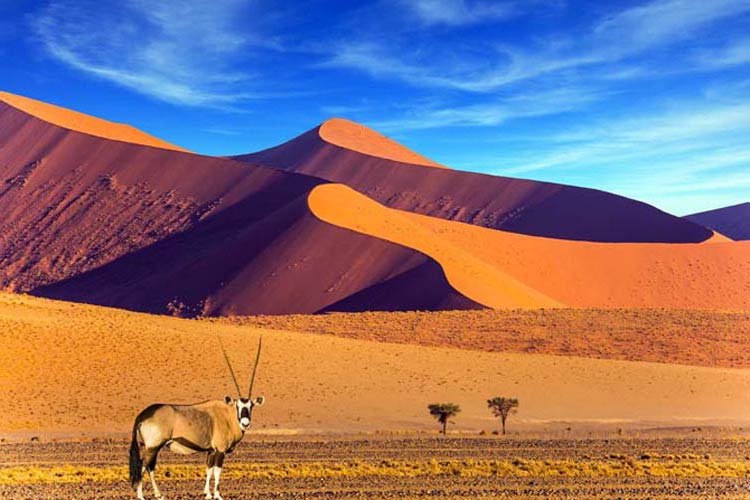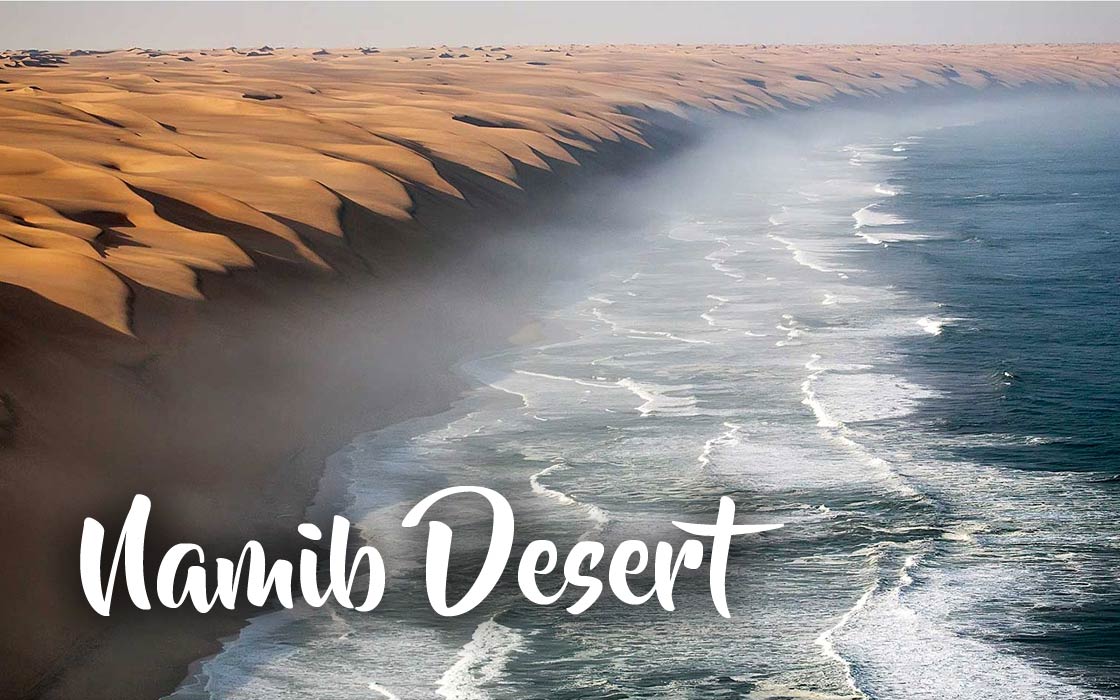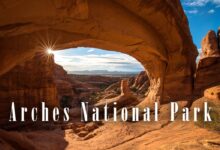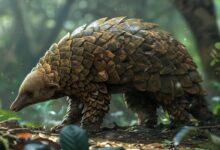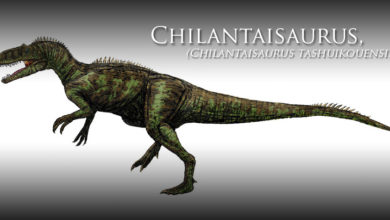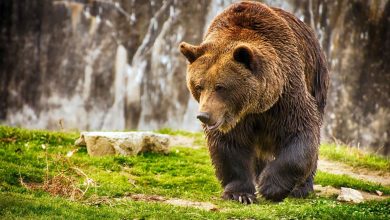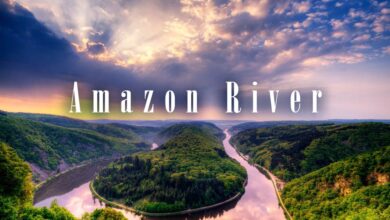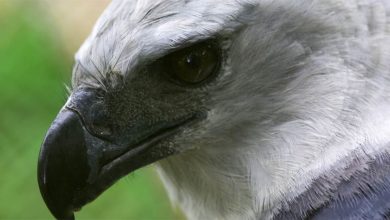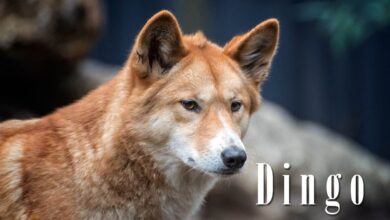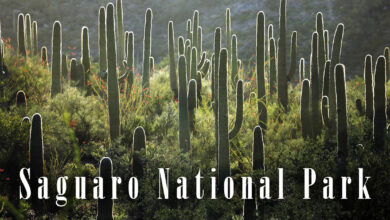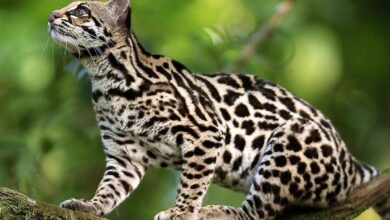Namib Desert
If a desert brings to mind an endless sea of sand, then we’ve hit the mark. Vast expanses of the Namib Desert are covered with golden-yellow sand, forming dunes stretching for kilometers (miles) from north to south and capable of reaching even 300 meters (984 feet) in height. It is one of the driest places on Earth, with rainfall occurring every few years and usually lasting only a few days; precipitation does not exceed 12 milliliters per m2 annually.
In this respect, the Namib surpasses even the drastically dry climates of the Gobi or Sahara deserts. The only source of moisture is fog traveling from the Atlantic – a result of the cold Benguela Current, which cools the air above the ocean, causing it to rise and move inland. Only thanks to this phenomenon is any vegetation possible in the Namib Desert. Therefore, if we want to see with our own eyes the undulating sea of immeasurable sand and experience great emptiness, far from civilization, visiting this desert is certainly a good idea.
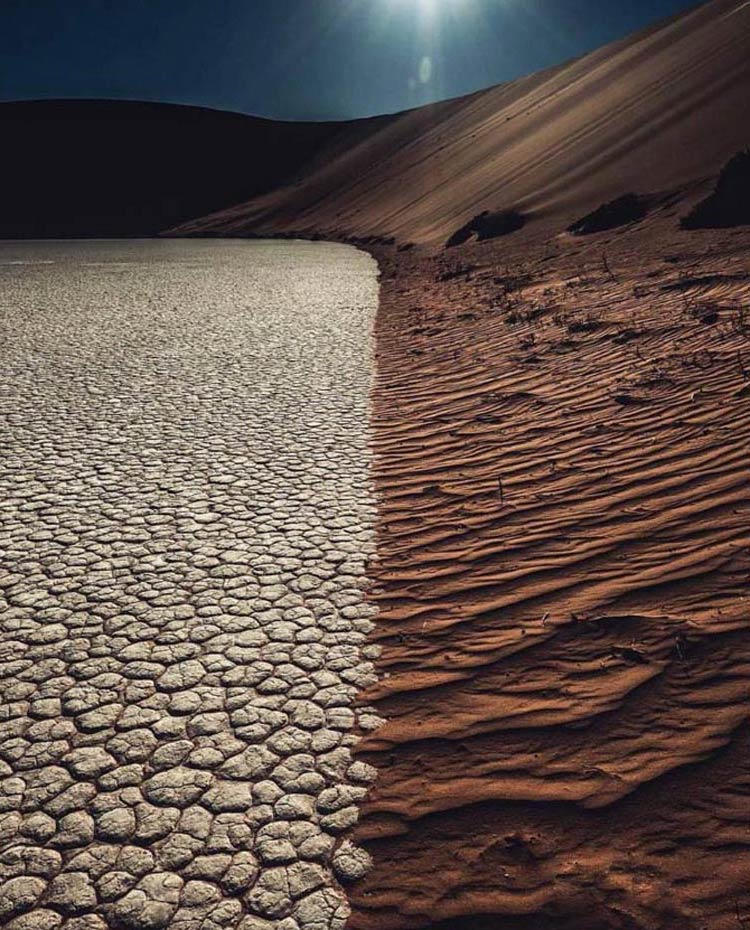
Where there is nothing
In local dialects, the definition of the desert means “a place where there is nothing,” which very accurately reflects the nature of these terrains. The Namib Desert is very extensive, over 1600 kilometers (approximately 994 miles) long, sometimes as wide as 160 kilometers (approximately 99 miles), and its area is about 160,000 km2 (approximately 61,776 square miles). If we add to this the fact that there is almost nothing there except sand, heat, and migrating dunes, we can understand the phenomenon of emptiness that fills the Namib Desert. It is also the oldest desert in the world, estimated by scientists to be almost 80 million years old.
It is located primarily in Namibia and occupies as much as 15% of the entire country. It stretches along the Atlantic coast from the border with Angola in the north to the border with South Africa in the south. The Namib is divided into two main parts, with the Kuiseb River as the border.
The northern part of the Namib Desert (partially in the territory of Angola) is a highland and somewhat rocky landscape. Here we find granite and limestone inselbergs. On the Atlantic side lies a park bearing the spooky name of the Skeleton Coast, although local sailors often use the name “The Gates of Hell.” Where do such associations come from? Well, this region experiences very strong sea currents that can prove deadly for ship crews. These sea currents are “led” by the powerful Benguela Current.
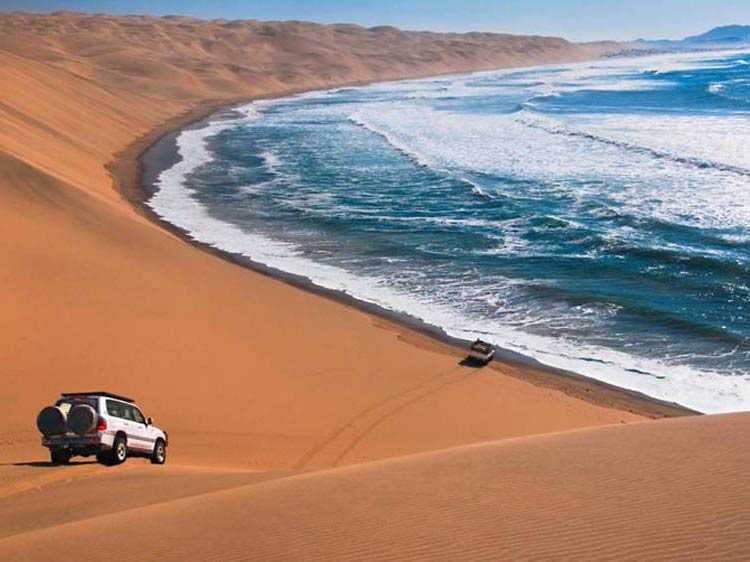
However, this is not the only danger. In the Skeleton Coast area, navigation is also significantly hindered by treacherous shallows. To this day, many of the ships that failed to turn back remain off the coast of the Namib Desert as structures of rust and bent metals – skeletons from which the coast took its name. Although contemporary sailors have the most modern navigational equipment at their disposal, they still have to fight a life-and-death battle with the relentless elements. The seabed in these areas is constantly changing as large underwater dunes, formed by wind-blown sand, move across it.
The southern part of the Namib Desert is a true sea of sand, which shimmers with different colors at every time of day. The closer to the ocean, the more yellow it becomes, in contrast to the reddish hue deeper inland. The sand forms dunes that can be hundreds of kilometers (miles) long and stretch in entire belts, usually in north-south directions. Their shape, size, and location are determined by the constantly blowing wind. In addition to traditional dune chains (which can be more than 300 meters (984 feet) high!), there are also spectacular star dunes.
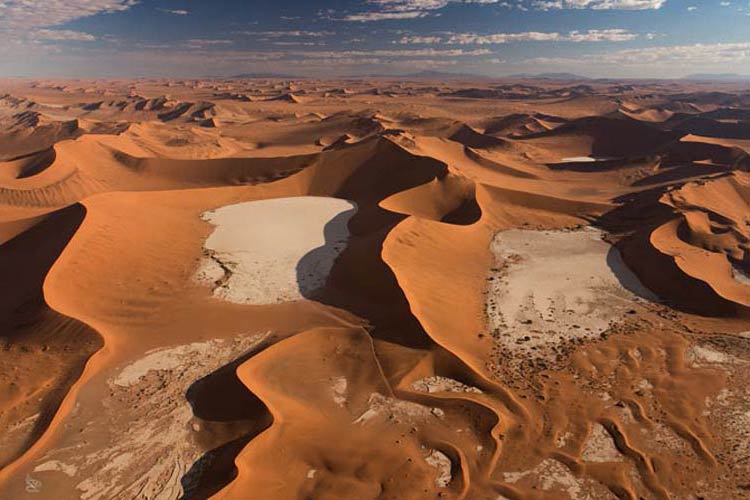
Constant lack of water
The Namib Desert is one of the driest and hottest places on our planet. Dramatically harsh conditions prevail here. It rains once every few years, and it is a short-lived downpour, usually accompanied by a violent storm. The riverbeds of ephemeral (periodic) rivers then fill up, and raging torrents of water rush through them. Dry valleys turn into meadows, and the desert briefly comes to life. However, this lasts for a very short time.
Why is it so dry here?
Firstly, the moisture carried by the trade winds from the Indian Ocean is stopped by the Drakensberg Mountains in South Africa. Therefore, when they reach the Namib Desert, they have lost so much moisture that only wind remains. Secondly, the culprit is the Arctic Benguela Current, which flows along the coast of southwestern Africa. Winds blowing from the desert are cooled by the current, and the effect is that a wave of cold air is covered by warm (and lighter) air. As a result, clouds do not form. Instead, fog develops, which is the only source of moisture that reaches the desert.
In an east-west arrangement, the Namib is divided into three zones: coastal, central, and inland. The coast has the lowest rainfall, low temperatures, and small temperature ranges. The further away from the Atlantic, through the central region to the inland, the amount of rainfall increases (a peculiar paradox and an example of how strongly sea currents affect the climate), and the temperature ranges go up. Seasonal fluctuations exceed the range from 0 to 50°C (32 to 122°F). However, the Namib is known for the fact that the sand can reach temperatures of 80°C (176°F) here.
It does not rain in the desert, and it also suffers from a lack of shallow surface water, which saves vegetation, for example, in the Kalahari Desert. Here, one can only count on fog, and only about 50 kilometers (approximately 31 miles) from the ocean and only for about 40 days a year. For this reason, almost all rivers in the central and southern Namib are periodic. The most important of these, which divides the desert into the highland-rocky north and the sandy south, is the Kuiseb River.
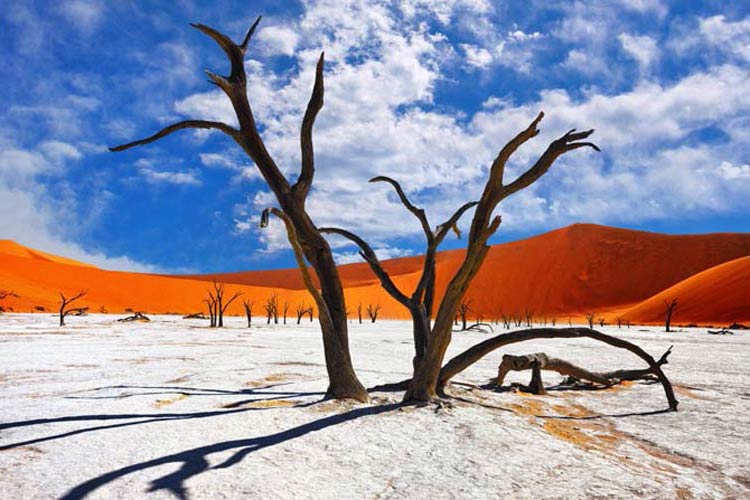
Fauna and flora
It might seem that no organism could survive in such drastic conditions. However, the Namib Desert is full of life, although it is a modest existence. Many of the species are endemic, having adapted to the harsh life in these areas.
Many species of lizards live here, including chameleons, as well as numerous insects. Buried in the sand for most of the hot day, they leave their hiding places at dawn to collect drops of morning dew. Many of them also dig special tunnel systems (like the spider called the “dancing white lady” (Carparachne aureoflava), which lines its tunnels with a thick layer of cobwebs, preventing them from collapsing).
In addition to reptiles, arachnids, and beetles, we also encounter mammals here. The Cape golden mole (Chrysochloris asiatica) is a specialist in burrowing among the dunes, where it searches for insect larvae and small reptiles. Among the larger animals in the Namib Desert, we can find the gemsbok (Oryx gazella), a unique type of antelope that can survive many days without water and has a special kidney structure. Sometimes, rhinoceroses or zebras can also be seen, and elephants and lions also occur.
In the Namib Desert area, we find over 100 species of plants. The most popular among them is the welwitschia (Welwitschia mirabilis). Such a plant can be several thousand years old, and its leaves can be up to 10 meters (33 feet) long – a true display of extravagance in such an inhospitable terrain. The remarkable quiver tree / kokerboom (Aloidendron dichotomum) also grows here (yes, its wood is used to make quivers for arrows). This succulent can reach a height of up to 9 meters (30 feet).
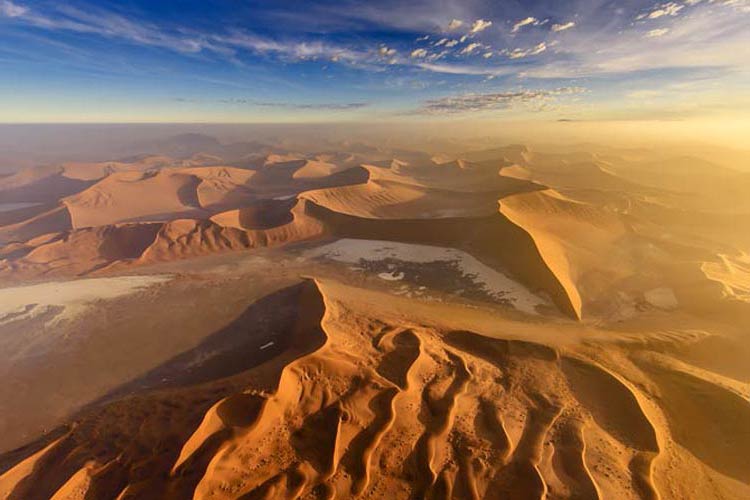
Namib-Naukluft National Park
This national park was established in 1979 and was created by merging two important protected areas: the Namib Desert National Park and the Naukluft Mountain Zebra National Park. It is a true giant in terms of area, covering almost 50,000 square kilometers (exactly 19,215 sq mi). The park encompasses coastal areas and also includes impressive dunes.
Within the park, many endemic species of plants and animals live. They are perfectly adapted to the harsh conditions because the climate in the Namib has not changed for millions of years, and it should be remembered that it is considered the oldest desert in the world. Here, we find several dozen species of grasses and lichens, and among the animals, lizards, beetles, spiders, as well as jackals, antelopes, and mountain zebras (Equus zebra), a species that already had its own national park in these areas.
The Skeleton Coast region, where the wrecks of ships that lost their battle with the elements loom, also includes a national park, established in 1971. Only the southern part of the park is accessible to tourists.
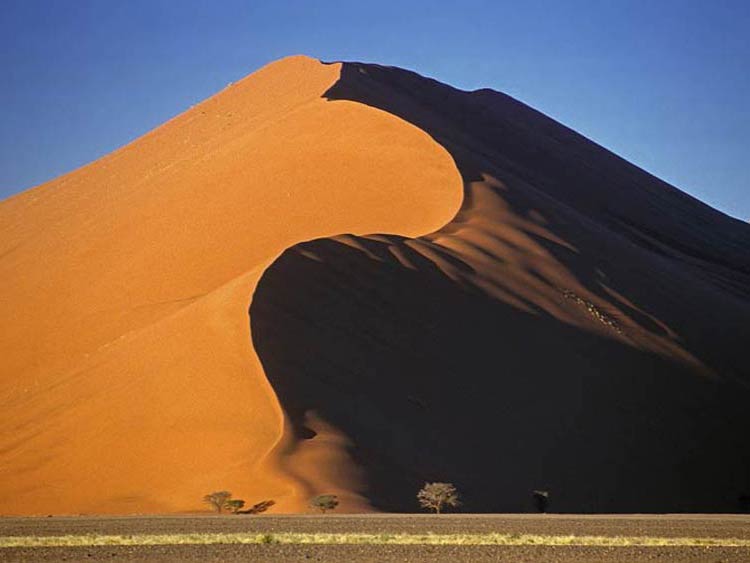
Detailed data
Namib Desert in numbers
- Desert length: 1600 km (approximately 994 miles)
- Desert width ranges from 50 kilometers (31 miles) at its narrowest point to a record 160 kilometers (99 miles) at its widest
- Namib Desert covers an area of almost 160,000 km² (61,776 square miles)
- Dunes in the southern part of the desert exceed 300 meters (984 feet) in height
- In the hottest places, sand temperatures reaching 80 °C (176 °F) are recorded here. Air temperature often exceeds 45 °C (113 °F).
- The Namib Desert, together with the Mountain Zebra National Park, forms one large national park, which was established in 1979.
- It is estimated that the desert may be up to 80 million years old and is considered the oldest desert in the world.
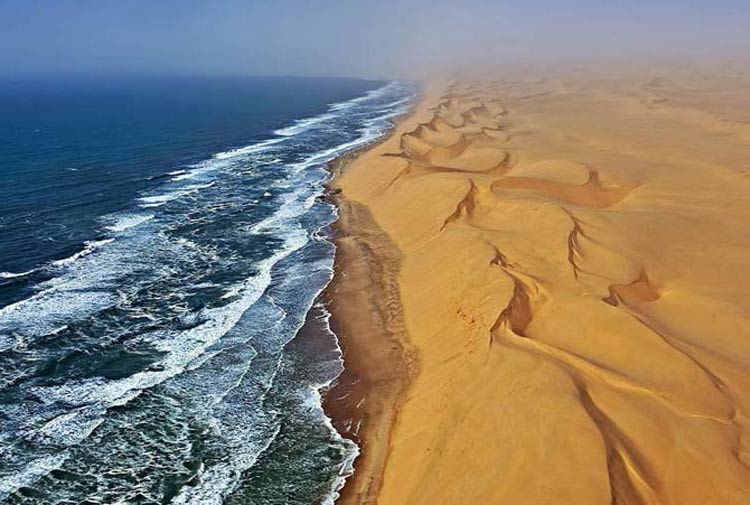
Namib Desert – interesting facts
- The dunes located in the Namib Desert are so unique that they were inscribed on the UNESCO World Heritage List in June 2013. The area is called the Namib Sand Sea.
- In and around the desert areas, many nomadic tribes live, wandering from place to place. They are primarily engaged in cattle breeding.
- To a large extent, thanks to the desert, Namibia as a country is among the least densely populated countries in the world. Only Mongolia can compete with it.
- In one of the episodes of the Namibia Special (TGT) of the popular program The Grand Tour, the presenters begin their journey on the coast of Namibia and travel in their cars through the Namib Desert, looking for a way that would allow them to get out of the inhospitable region to civilization.
